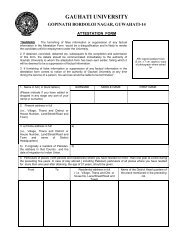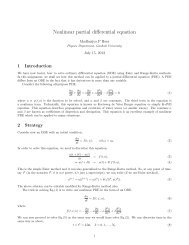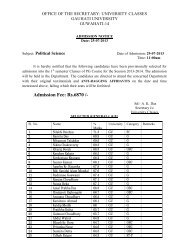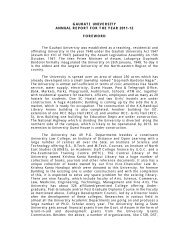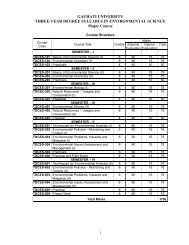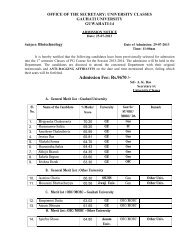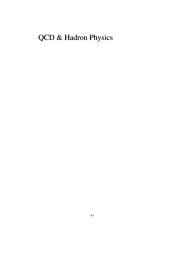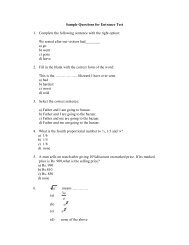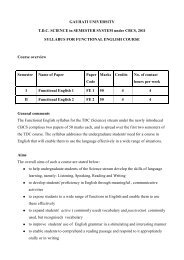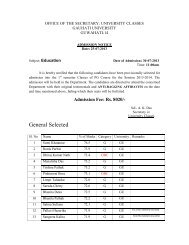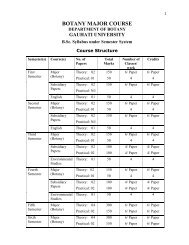Regulation of TDC for Semester System - Gauhati University
Regulation of TDC for Semester System - Gauhati University
Regulation of TDC for Semester System - Gauhati University
You also want an ePaper? Increase the reach of your titles
YUMPU automatically turns print PDFs into web optimized ePapers that Google loves.
9. No “repeat” /”betterment” shall be allowed in the practical examinations in any<strong>Semester</strong>.10. A student must pass all his <strong>Semester</strong> examinations, including “repeat” and‘betterment’ chances within five years from the date <strong>of</strong> admission to the First<strong>Semester</strong> course. A student will get a maximum <strong>of</strong> three chances to clear aparticular <strong>Semester</strong>.11. In case <strong>of</strong> any dispute regarding evaluation or un<strong>for</strong>eseen events the matter maybe placed in the Committee <strong>of</strong> Courses and Studies (U.G) <strong>for</strong> amicablesettlement.12. Since the <strong>Semester</strong> involve continuous assessment there would be no scope <strong>for</strong> astudent to appear as a private candidate in any subject.13. For any matter not covered under this <strong>Regulation</strong> <strong>for</strong> semester <strong>System</strong>. Theexisting <strong>University</strong> Rules and the <strong>Gauhati</strong> <strong>University</strong> Act 1949 (as amended tilldate) should be applicable.Annexure --- IAcademic Calendar and Schedule <strong>for</strong> <strong>Semester</strong> <strong>System</strong>(A) Admissions- June(B) <strong>Semester</strong> I/III/V Classes- August - DecemberSessional Examination 1- SeptemberSessional Examination 2- NovemberFinal <strong>Semester</strong> Examination - December(including preparation <strong>for</strong> examinationAnnouncement <strong>of</strong> Results - by January(C) <strong>Semester</strong> Break - January 1—July 31(D) <strong>Semester</strong> II/IV/VI Classes - Jan — JuneSessional Examination 1- FebruarySessional Examination 2- AprilFinal <strong>Semester</strong> Examination - To be completed by June -30(including preparation <strong>for</strong> examination )Announcement <strong>of</strong> Results - First week <strong>of</strong> July.Note : The exact date <strong>of</strong> the sessional examinations shall be fixed by the concernedteachers/colleges and that <strong>of</strong> the final semester examination by the C.E.,G.U. TheController <strong>of</strong> Examinations would announce the results <strong>of</strong> the final examinations.Admissions will be given by following <strong>University</strong> Rules.
5. There is no provision <strong>for</strong> re-appearing or “repeat”/ “betterment” in the sessionalexamination. If a student miss one or both examination <strong>for</strong> valid reasons (asevidenced by medical certificate or other authentic documents) then the teacher/college concerned may allow the student a separate examinations using the teachersown discretion.6. If a paper is taught by more than one teacher then the concerned teacher should cooperatedin conducting the internal evaluation. Each sessional examination <strong>for</strong> aparticular paper should be one examination <strong>of</strong> one hour duration even if severalteachers may be teaching the paper. However, since the contents <strong>of</strong> a paper in asemester examination is approximately half that <strong>of</strong> a full paper in annual examination,it is strongly recommended that one paper in a semester system be taught by only oneteacher.7. At the end <strong>of</strong> the semester and be<strong>for</strong>e the final semester examination begin, theconcerned teacher(s) should submit the internal marks in proper marksheets alongwith the answer scripts to the C.E., G.U.8. The affiliated colleges should submit the internal evaluation marks and the answerscripts directly to the Controller <strong>of</strong> Examinations.9. Scrutiny <strong>of</strong> the answer scripts and scaling <strong>of</strong> the internal marks may be arranged bythe Controller <strong>of</strong> Examinations if necessary.Annexure ---IVProcedure <strong>for</strong> external evaluation1. The Committee <strong>of</strong> Courses and Studies (CCS-UG) <strong>of</strong> each department will meet in themonth <strong>of</strong> April and October to decide the dates <strong>of</strong> final examination <strong>for</strong> the on-goingsemester. The Head <strong>of</strong> the Department would notify these dates to the Controller <strong>of</strong>Examinations.2. The Controller <strong>of</strong> Examinations would make the necessary arrangement <strong>for</strong>announcing the date <strong>of</strong> examinations and other necessary procedures as per<strong>University</strong> Rules.3. Each paper will have 80% <strong>of</strong> the total marks <strong>for</strong> external evaluation. The finalsemester examination will be <strong>of</strong> three hour duration <strong>for</strong> a paper <strong>of</strong> 100 marks.4. The affiliated colleges should send the answer scripts <strong>of</strong> the external examinations tothe zonal <strong>of</strong>ficers as per direction <strong>of</strong> the C.E., G.U.5. The evaluation zone will arrange <strong>for</strong> evaluation and scrutiny <strong>of</strong> the final examinationanswer scripts. After evaluation and scrutiny the answer script is should be sent to theController <strong>of</strong> Examinations..6. The Controller <strong>of</strong> Examinations would make necessary arrangement <strong>for</strong> announcingthe results within two weeks <strong>of</strong> receipts <strong>of</strong> the answer scripts. Ef<strong>for</strong>ts must be made toannounce the results <strong>of</strong> semester examination on or be<strong>for</strong>e the schedule given in theAcademic Calendar (Appendix –I).7. For any procedure not mentioned above, the existing <strong>University</strong> <strong>Regulation</strong>s <strong>for</strong> P.G.Examinations would be applicable.
1. Definition <strong>of</strong> Credit:“CREDIT & GRADING”(a) The theory paper would have one credit <strong>for</strong> each hour <strong>of</strong> instruction per weekin a semester. The activities include lectures, tutorials and others <strong>for</strong> internal evaluation(Seminar, group discussion, laboratory/demonstration session mini project etc.)A theory paper (which is equivalent to 100 marks <strong>of</strong> course load) should be <strong>of</strong> 6(six) credit points which would consist <strong>of</strong> 4 hrs, <strong>of</strong> lectures and 2 hrs <strong>of</strong> tutorial & otheractivities. A theory paper <strong>of</strong> 50 marks would have 3 (three) credit points: 2 hrs <strong>of</strong> lectures+ 1 hrs tutorial (& others)For science subjects with practical one hour tutorial may be outside the <strong>of</strong>ficehours <strong>for</strong> home work, literature survey/internet browsing etc.(b) Practical papers / courses would have one credit point <strong>for</strong> every 2 hrs <strong>of</strong>laboratory work per week in a semester. If the number <strong>of</strong> hrs per week is anodd number, appropriate adjustment be made it to the nearest even number<strong>for</strong> example.1) 3 hrs lab per day x 2 days per week = 6 hrs = 3 credits2) 3 hrs lab per day x 3 days per week = 9 hrs = 4 credits3) 3 hrs lab per day x 6 days per week = 18 hrs = 9 credits.If the total number <strong>of</strong> practical courses is 18 hrs per week, then 3 hrs per week bedevoted as home work <strong>for</strong> preparing the report (i.e. lab book) and other activityrelated to practical.(c) P.G. Dissertation by research work /projects would be <strong>of</strong> 12 credit points by24 hrs <strong>of</strong> work per week in a semester. The dissertation would involveactivities such as literature survey preparation <strong>of</strong> project report, computation,seminar, presentation, demonstrations, viva-voce examinations, and (ifrequired) visit to other institutions or research lab <strong>for</strong> data collection etc.About six to nine hrs <strong>of</strong> work may be allowed to such activities outside classhours and about 18 to 15 hrs <strong>of</strong> work <strong>for</strong> the laboratory work.(d) Other type <strong>of</strong> work such as departmental seminar, field/industrial trainingwould be compulsory <strong>for</strong> the student, but no credit or marks <strong>for</strong> internalevaluation be assigned <strong>for</strong> such activities. Moreover, class attendance shouldnot be considered <strong>for</strong> internal (or external) evaluation. Attendance including<strong>of</strong> department seminars would be treated under the <strong>University</strong> rules <strong>of</strong>minimum 75% attendance required <strong>for</strong> appearing in the examinations.2. Total Credit per semester:Every student must complete a minimum <strong>of</strong> 30 credits per week in a semester,this amounts to about 30 hrs <strong>of</strong> contacts teaching per week. The total number <strong>of</strong>credit <strong>for</strong> a four semester course should be between 120-140. For a two semesteror a eight-semester course the total credit points may be worked out accordingly.3. Core Course and Elective courses:(a) Core courses are compulsory set <strong>of</strong> papers which also include those<strong>of</strong>fered <strong>for</strong> specialization in each branch <strong>of</strong> the subject. For example, theset <strong>of</strong> papers (theory & practical) <strong>of</strong>fered under specialization in physicalchemistry would be considered under core course <strong>for</strong> the concerned
Paper I-III Three theory papers – 3x6 credit = 18 creditsPaper –IV P.G. Dissertation / ProjectBy Research-= 12 credits…………………………………..Total = 30 credits4. Grading <strong>System</strong> :(a) Conversion <strong>of</strong> marks to Grades :Actual marks secured by a group <strong>of</strong> candidates are converted into RelativePercentile (R) be<strong>for</strong>e conversion into Relative Letter Grades. The maximumActual marks (i,e. Highest mark) (M) secured in a particular Group is convertedinto 100% and other actual marks (A) secured by the students <strong>of</strong> the same groupsare converted to the Relative Percentile.R= (100 / M)XA where R= Relative PercentileM= Maximum (Highest) marks in the classA= Actual marks <strong>of</strong> a student who passed I.e., if theactual marks is not less than 30%(b) Conversion Table <strong>for</strong> Relative Percentile into Letter Grades and Grade points.Range <strong>of</strong> Relative Letter GradesGrade pointPercentile90-10075-8955-7440-5430-39If A / or F is below 30 %ABCDEF1086420(C) Conversion <strong>of</strong> Grades <strong>of</strong> CGPA & CPI :Grade point average (GPA) is used as a numerical survey <strong>of</strong> academicachievement, First, Grades are assigned to points in a 10 points scale as follows:A= 10 points, B= 8 points, C= 6 points, D= 4 points, E= 2 points, F=0 points.Secondly, the hours <strong>of</strong> credit <strong>for</strong> each course are multiplied by the Grade pointvalue to determine the honour points. The honour points are then added <strong>for</strong> all the courses/ papers in a <strong>Semester</strong>. The same <strong>of</strong> honour points in a given semester is then divided bythe total number <strong>of</strong> credits.Example :Course No.Course/PaperCredit Grade Point HonourPointChem-401 12 A 10 120Chem-401 12 B 8 96Chem-420 12 C 6 72Chem-60X 8 D 4 32Chem-430Laboratorywork16 A 10 16060 480Grade point average (GPA) = 480 / 60 = 8.0
Cumulative Per<strong>for</strong>mance Index (CPI):The final result <strong>of</strong> a four <strong>Semester</strong> Course is expressed as the average Gradepoints obtained by the student in the entire course:CPI = (CPA) Sem-I+ (GPA) Sem-II (GPA) Sem-III+GPA Sem-IV / 4(d) Conversion Formula: <strong>for</strong> m Grades to P.C. <strong>of</strong> marks <strong>for</strong> Humanities and SocialScience:For CGPA upto 9.5 : (5XCGPA)+20For CGPA above 79.5 : (65XCGPA) -550So, <strong>for</strong> c lass-I minimum CGPA be 8For class –II minimum CGPA be 5For other subjects / disciplines :For CGPA upto 9.00 : (10 X CGPA)-5For CGPA above 9.00(15 X CGPA)-50In order to qualify <strong>for</strong> a P.G. degree a student must secure CGPA <strong>of</strong> minimum 5.0(equivalent to 45% marks).Note :(1) There will not be any limit regarding the number <strong>of</strong> failed papers <strong>for</strong>enrolling in the next higher semester class.(2) A candidate who fails to clear certain papers in a particular semestershe/he may be allowed to repeat papers in the next opportunity or aftercompletion <strong>of</strong> the 4 th <strong>Semester</strong>. For repeating a course a student shouldattend all the c lasses and complete internal and external examinations.(3) However, in order not to overload the students with courses, a studentshall not be allowed to register <strong>for</strong> courses not more than 34 credits in asemester. If there is clash in the routine, she/he should repeat previoussemester courses first and then opt <strong>for</strong> remaining paper(s) in the nextopportunity or after completion <strong>of</strong> the semester.(4) Special Summer Course may be arranged by the respective P.G. Deptts <strong>of</strong>the <strong>University</strong> <strong>for</strong> repeater candidates provided the concerned teachersagree to conduct these courses during summer vacation. A repeaterstudent shall be allowed to register not more than 2 (two) such courses inone summer semester. There should be minimum 30 one hour lectures <strong>for</strong>each course including examinations.5. Examination and Evaluation :(1) The pass marks in each paper is 30 % <strong>of</strong> total marks in that paper(external+internal)(2) A student who fails in one or more papers should repeat the papers byattending all the classes and by appearing <strong>for</strong> internal as well as externalexaminations at the next opportunity. A student shall get three chances<strong>for</strong> clearing the papers within five years from the date <strong>of</strong> admission to thedegree programme.
(3) A student who has completed a semester may be allowed to proceed tothe next semester irrespective <strong>of</strong> number <strong>of</strong> papers where the studentfailed.(4) In order to complete a course a student must obtain pass marks in all thepapers in the semesters <strong>of</strong>fered to the student in the degree course (PG orUG).(5) A student who fails in elective papers may be allowed to replace them byother elective papers <strong>of</strong> the same credit after obtaining prior approvalfrom the department. For this the procedure <strong>for</strong> repeating (as in (2)above) would be applicable.(6) Students who secure the lowest grade (viz. E grade) may be given theoption to repeat that paper by following the procedure <strong>for</strong> repeating (as in(2) above)(7) Internal Evaluation: the following guidelines be followed.(i) For every paper there should be a separate internal evaluation conductedby the teachers involved in teaching that paper.(ii) Each teacher involved in teaching a paper would conduct a one-hourwritten examination <strong>of</strong> (16-20% marks) some time in the middle <strong>of</strong> the<strong>of</strong> the semester. If seminars or group discussions are held as a part <strong>of</strong>internal evaluation, then each student should submit a report, which maybe assigned about 4% marks (within 20%) in internal evaluation.(iii) The mid semester examination answer scripts (with marking) should beshown to the student so that they are aware <strong>of</strong> the progress made bythem in the course.(iv) Attendance in class should not be considered <strong>for</strong> internal evaluation.



